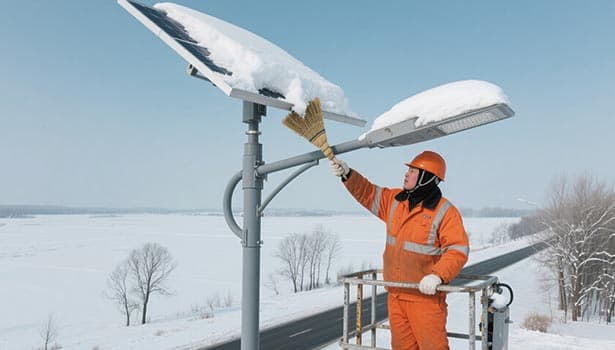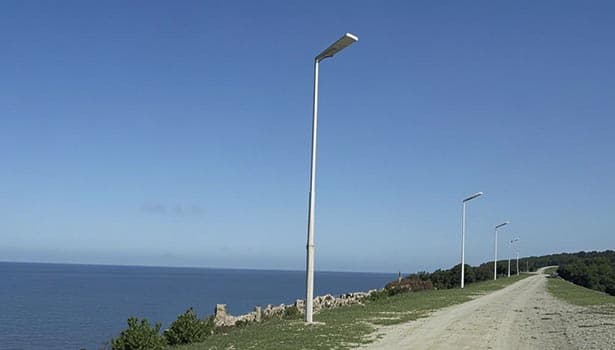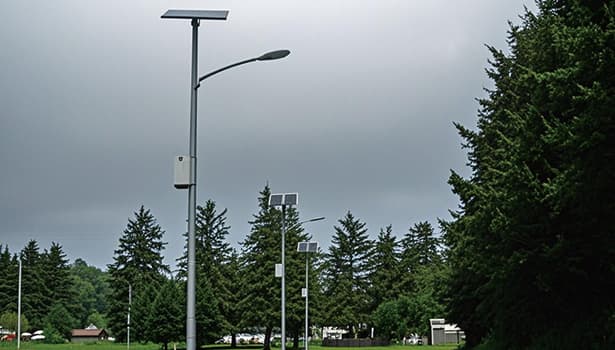Why You Need to Clean the Dust on the Solar Street Light in Time?
As a typical representative of green energy applications, solar street lights are widely used in city roads, country trails and even park lighting due to their environmental friendliness and low maintenance cost. However, a key detail that is often overlooked is quietly eroding the performance of these devices - dust accumulation. Data shows that the output of solar panels that are not cleaned in a timely manner can drop by up to 60%, a problem that can be avoided with regular maintenance. In this article, we will comprehensively dismantle the necessity of “timely cleaning” from the principle, hazards to solutions, and help readers establish a scientific concept of maintenance.

How Does Dust Affect Solar Street Lights?
The “Roadblock” of Light Energy Absorption
The core working principle of solar street light is to absorb light energy through solar panels and convert it into electricity to power the lighting system. When pollutants such as dust, bird droppings, fallen leaves, etc. cover the surface of the panel, it will firstly lead to a significant decrease in the light transmission of the panel. Secondly, the accumulation of pollutants will change the angle of incidence of light, so that the light energy can not be evenly spread within the glass cover, directly affecting the light absorption efficiency of the solar panel.
According to relevant research data, panels covered with dust have at least 5% lower power output than panels in a clean state. This effect does not grow linearly - the shading effect worsens exponentially as dust continues to accumulate. For example, when a neighborhood solar streetlight was not cleaned for six months, its nighttime lighting hours were drastically reduced from the initial 8 hours to 4 hours, and the brightness of the illumination dropped by nearly half.
Accelerated Aging of the “Invisible Killer”
Dust adheres to the surface of the panel, forming an invisible “thermal resistance layer”. Although dust itself does not directly raise or lower the panel temperature, its accumulation can impede the panel's heat dissipation efficiency. Solar panels are extremely sensitive to temperature changes, and studies have shown that for every 1°C rise in panel temperature, their output power drops by about 0.4%.
More seriously, localized dust accumulations tend to warm up faster than other areas, which can trigger the “hot spot effect”. When the temperature in a certain area is too high, it will not only significantly reduce the power generation efficiency of the area, but also may lead to localized burnout of the panels, and even trigger safety hazards such as short circuits in the lines. An industrial park had a long time due to solar panels are not clean, hot spot in the summer hot weather, ultimately leading to the scrapping of the entire panel, the cost of repair more than a thousand dollars.
Catalyst for Accelerated Panel Corrosion
Atmospheric dust is not a single substance, and can contain acidic or alkaline particles. When these particles meet water (such as rain, dew), will form a corrosive solution on the surface of the panel, and the glass panel chemical reaction. With long-term accumulation, irreversible damage such as pits and roughness will gradually appear on the panel surface, further reducing light transmission.
In industrial areas, coastal areas and other special environments, the corrosion effect is particularly obvious. A coastal city of solar street lights, due to the sea breeze brought about by salt-containing dust and acid rain together, the panel transmittance decreased by 15% in 1 year, the original design life of 25 years of the panel had to be replaced in advance, the overall maintenance costs increased by 3 times.
The “Vicious Cycle” of More and More Dust Accumulation
Dust itself has adsorption properties, and its surface is prone to static electricity, which attracts more dust particles. If not cleaned in a timely manner, the initial small amount of dust can quickly accumulate in a short period of time, creating a vicious cycle of “dirty - dirtier”. The rate of accumulation is particularly noticeable in windy and sandy areas and on heavily traveled roads, where it can take as little as 1-2 months for the panels to become covered with a thick layer of dust.
Why is “Waiting for Rain” A Misconception?
Limitations of Rainwater Cleaning
Many people believe that rainwater can naturally clean solar panels without the need for manual maintenance. This is a serious misconception. In fact, not only does rainwater fail to completely remove all contaminants, it may even exacerbate the problem:
Hard water residue: In areas with hard water, calcium, magnesium and other minerals in rainwater will evaporate and form water alkali on the panel surface, instead increasing shading;
Pollutant buildup: mud, bird droppings, and other pollutants that accompany rain can form stubborn stains on the panels that are more difficult to remove when dry.
Solar Panel Efficiency Drops Faster During the Rainy Season
Relevant studies have shown that in the rainy season, the efficiency of solar panels drops faster than in the dry season. This is because rainwater washes away some of the large particles of pollutants, but it is unable to remove microscopic dust and sticky substances (such as insect secretions). In addition, the humid environment will make it easier for dust to adhere to the panel surface, forming a layer of dirt that is difficult to remove.

Multiple Values of Timely Cleaning of Solar Street Lights
Photovoltaic System Efficiency Improvement
Timely cleaning of solar panels can significantly improve the system's power generation efficiency. Data shows that commercial solar installations can see up to a 60% increase in efficiency after cleaning, while residential PV systems see an increase in efficiency of about 21%. This efficiency improvement translates directly into increased power generation, which means longer lighting hours and more consistent brightness output for streetlights that rely on solar power.
Extending the Life of Solar Street Lights
Regular cleaning effectively reduces hot spot effects and corrosion damage, keeping the actual lifetime of solar panels close to the design value (25-30 years). On the contrary, if the panels are not cleaned for a long time, the panels may be severely deteriorated within 5-10 years and have to be replaced earlier. Taking a solar street light as an example, the cost of replacing panels accounts for about 40% of the entire cost of the machine, and regular cleaning can significantly reduce this part of the expenditure.
Warranty for Solar Street Lights
Most solar street light manufacturers will explicitly require users to carry out regular maintenance when they offer a 25-30 year warranty. If the panel fails due to a lack of cleaning, the manufacturer may deny the warranty and the user will be responsible for the repair costs. A municipal project had a significant drop in panel efficiency during the warranty period due to a failure to clean as required, and ultimately had to replace the panels at its own expense, with a loss of tens of thousands of dollars.
Enhance the ROI of Solar Street Lights
For municipal projects, business parks and other large-scale application scenarios, timely cleaning of solar street lights can significantly improve the return on investment (ROI). A case study of a municipal street lighting project shows that through regular quarterly cleaning, the savings in electricity costs are 30% higher than when the lights are not cleaned, and the overall payback cycle is shortened by 2-3 years. In the long run, the cost of cleaning is much lower than the economic loss caused by efficiency loss.
Cleaning Strategy for Solar Street Lights
Cleaning Frequency
The cleaning frequency of solar street light needs to be set by comprehensively considering the environmental factors and equipment use scenarios, and requires scientific planning rather than “doing it when you think of it”:
Routine frequency:
It is recommended to clean every 6 months, with the best time point being the end of summer and the end of winter. These two seasons are respectively high temperature and dust and rain and snow pollution, cleaning can effectively remove the accumulated pollutants;
Special scenario adjustments:
Industrial and sandy areas: Clean every 3 months to avoid rapid accumulation of industrial dust and sand;
Areas with high bird activity: need to increase the frequency of inspections and clean immediately when bird droppings and other stains are found to avoid corrosion of panels by acidic substances;
High humidity or coastal areas: clean every 4-5 months to prevent salt spray and mold adhesion.
Safe Cleaning Steps for Solar Street Lights
Time and weather
Best time: Choose to clean in the evening or early morning, when the panel temperature is lower, to avoid rapid evaporation of cleaning agent due to high temperature, and to reduce the risk of operator burns;
Weather Taboo: Avoid cleaning in hot sun, heavy rain or windy weather to prevent slipping, electrocution or uneven drying of the cleaning agent.
Tool and cleaner selection
Recommended tools:
Soft fiber bristle brush or sponge: for gently wiping the surface of the panel to avoid scratching the glass;
Low-pressure water gun: water pressure control at 0.2-0.3MPa for rinsing stubborn stains;
Long-handled cleaning rod: suitable for high-altitude street lamps to avoid the risk of climbing;
Cleaning agent selection: use neutral pH value of the special solar panel cleaner, or diluted mild detergent (concentration of not more than 5%), is strictly prohibited to use strong acidic or strong alkaline cleaner;
Prohibited tools:
steel wire ball, hard scraper, high-pressure water gun (pressure over 0.5MPa), these tools may damage the panel surface of the anti-reflective coating or sealing tape.
Operation procedure guide
Rinse the surface of the panel with a low-pressure water gun to remove large particles of dust and debris;
Dilute the cleaner and spray evenly on the panel, wait for 1-2 minutes for the stains to soften;
Scrub the panel gently with a soft bristle brush, paying attention to one direction to avoid rubbing back and forth;
Rinse thoroughly with a low-pressure water jet again to ensure the cleaner is completely removed;
Dry the edges of the panel with a clean, soft cloth to prevent water spots from remaining;
After the cleaning is completed, check whether the panel is broken and whether the wiring is loose, and complete the synchronized inspection.

Solar Street Light Intelligent Self-Cleaning Technology Innovation
Technical principle and advantages
With the advancement of technology, the intelligent self-cleaning system has become an efficient solution to the dust problem. Driven by solar energy, the system can automatically clean the panels every morning and evening without manual intervention. Its core advantages include:
Efficiency guarantee: Continuously maintains panel light transmittance and avoids over 50% efficiency loss due to dust obstruction;
Cost saving: Long-term maintenance-free after a one-time investment, especially suitable for high-altitude installation or large-scale street light networks;
Environmental adaptability: some systems integrate temperature control function, which can work normally in the cold environment below - 20℃;
Synchronized cleaning: some high-end systems can clean the solar panels and street light covers at the same time to ensure that the lighting brightness is not affected.
Comparison of technology types
|
Technology Type |
Working Principle |
Maintenance Cost |
Suitable Scenarios |
|
Spray-Type Self-Cleaning |
Water tank + nozzles periodically spray to rinse |
Medium |
Regular urban roads |
|
Brush-Type Self-Cleaning |
Motor-driven brush wipes back and forth |
High |
Windy and dusty areas |
|
Nano-Coating Self-Cleaning |
Ultra-hydrophobic nano layer coated on panel surface |
Low |
Rainy regions |
|
Electrostatic Dust Removal |
High-voltage electrostatics attract dust particles |
Medium |
Industrial and mining zones |
Intelligent self-cleaning system selection points
Cleaning efficiency: Priority is given to the combination of water spray + brush composite system to adapt to a variety of pollutants;
Energy consumption control: the energy consumption of the self-cleaning system should be less than 5% of the average daily power generation of street lights;
Protection level: IP65 or above to ensure normal work in rain and snow;
Remote monitoring: support IOT platform access, real-time view of the cleaning status and equipment data.

Conclusion
The cleaning of solar street light is not a trivial matter, but a core part of the system efficiency, life and cost. Whether using traditional manual cleaning or intelligent self-cleaning technology, “timely action” is the key to maximize the environmental and economic value of solar energy. In the trend of smart city and low carbon development, paying attention to this detail is an important step towards efficient and sustainable lighting.
For municipal managers, property maintenance personnel and individual users, the establishment of a scientific concept of maintenance, cleaning into the regular management, not only to ensure the stable operation of street lights, but also in the long-term use of economic and environmental benefits of a win-win situation. With the continuous progress of technology, intelligent self-cleaning and other innovative programs will further reduce the maintenance threshold, so that the solar street light truly become a “save heart, save energy, save money” green lighting options.
Common Cleaning Misconceptions and Pit Avoidance Guidelines for Solar Street Lights
Misunderstanding 1: Cleaning with washing powder
Laundry detergent is mostly alkaline, long-term use will corrode the panel sealing tape, it is recommended to use neutral cleaner.
Misunderstanding 2: Rinse with high pressure water gun
High-pressure water flow may lead to water ingress at the edge of the panel, and even damage the internal circuit of the solar street light, the water pressure should be controlled below 0.3MPa. ·
Misunderstanding 3: Only clean the panel without checking the equipment
When cleaning, you should synchronize the inspection of solar street light foundation, junction box, battery compartment and other parts of the solar street light, and find out the hidden dangers such as loosening, rusting and corrosion in time.
Through scientific cleaning strategy and technology application, solar street light will really play its “inexhaustible” energy advantage, and contribute more value to the green city construction.




